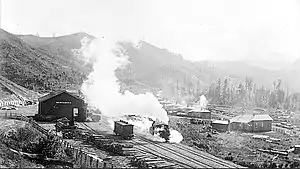Mangaweka railway station
Mangaweka railway station was a station on the North Island Main Trunk, serving the village of Mangaweka in the Manawatū-Whanganui region of New Zealand. The original station opened in 1902 and closed on 15 November 1981.[1][2][3] A new station then opened to the east,[4] on the Mangaweka deviation on 18 November 1981, though only for parcels, small lots, and as a passing loop,[5] which still remains.[6]
Mangaweka railway station | |||||||||||
|---|---|---|---|---|---|---|---|---|---|---|---|
 Mangaweka railway station about 1902 | |||||||||||
| Location | New Zealand | ||||||||||
| Coordinates | 39.821179°S 175.77522°E | ||||||||||
| Elevation | 327 m (1,073 ft) | ||||||||||
| Line(s) | North Island Main Trunk | ||||||||||
| Distance | Wellington 231.04 km (143.56 mi) | ||||||||||
| History | |||||||||||
| Opened | 3 November 1902 | ||||||||||
| Closed | Passengers 18 April 1971 Goods before 1993 | ||||||||||
| Electrified | June 1988 | ||||||||||
| Services | |||||||||||
| |||||||||||
The station was important as the terminus of the line from Wellington from 1902 to 1904.
History
An advert for timber for the station building was placed on 13 December 1901.[7] Dates from 3 July to 30 August 1902 are mentioned for opening goods traffic to Mangaweka and 30 October for inspection of the 9 mi 20 ch (14.9 km) line from Mangaonoho to Mangaweka. New Zealand Railways (NZR) took the line over from the Public Works Department on Monday, 3 November 1902, when the stationmaster was transferred from Ōhingaiti to Mangaweka and the station was noted as having a passenger platform, 84 wagon passing loop, privies, urinals, goods shed 72 ft (22 m) by 42 ft (13 m), loading bank, sheep and cattle yards, water service (one 2,000 gallon vat), coal shed 24 ft (7.3 m) by 16 ft (4.9 m), engine shed 72 ft 6 in (22.10 m) by 21 ft 6 in (6.55 m), with a 59 ft (18 m) long pit, and stationmaster's house. On 1 November 1904 a cart approach and crane were also mentioned and a warehouse crane and stockyard upgrade came in 1913.[5]
Dates for the extension northwards are also varied. 9 June to 4 August 1904 are given for when the 7 mi 75 ch (12.8 km) extension from Mangaweka to Utiku opened for goods. Passenger trains started running to Taihape on Friday, 12 August 1904, though it wasn't until Tuesday, 1 November 1904 when NZR took over the 12 mi 76 ch (20.8 km) Mangaweka to Taihape section.[5]
In 1957 the passing loop was extended and motor points and colour light signals installed.[5]
tWhen passenger trains stopped calling from Sunday, 18 April 1971, much of the station building had been demolished, though in 1980 a station building, goods shed, loading bank, and 1½ ton crane remained. A new station opened on Wednesday, 18 November 1981,[5] but closed before 1993.[1]
Incidents
A slip derailed a locomotive at the entrance to the tunnel in 1913.[8] A goods train derailed, breaking several trucks and some track, in a cutting on the Mangaweka side of Mangaweka Viaduct in 1930.[9][10]
References
- Juliet Scoble: Names & Opening & Closing Dates of Railway Stations in New Zealand
- New Zealand Railway and Tramway Atlas (First ed.). Quail Map Co. 1965. pp. 3 & 4.
- Pierre, Bill (1981). North Island Main Trunk. Wellington: A.H&A.W Reed. pp. 289–290. ISBN 0589013165.
- "1:63360 map Sheet: N139 Mangaweka". www.mapspast.org.nz. Retrieved 13 January 2021.
- "Stations" (PDF). NZR Rolling Stock Lists. Retrieved 10 August 2020.
- "Manawatu Scenic Rte". Google Maps. July 2020. Retrieved 13 January 2021.
- "WANGANUI HERALD". paperspast.natlib.govt.nz. 14 December 1901. Retrieved 13 January 2021.
- "LANDSLIPS ON THE MAIN TRUNK RAILWAY: THE OHINGAITI TUNNEL. NEAR MANGAWEKA, SHOWING AN ENGINE DERAILED BY A FALL OF EARTH. NEW ZEALAND HERALD". paperspast.natlib.govt.nz. 29 October 1913. Retrieved 17 January 2021.
- "TRAIN WRECKED ON THE NORTH ISLAND MAIN TRUNK LINE LAST WEEK". www.aucklandcity.govt.nz. 10 September 1930. Retrieved 17 January 2021.
- "MANGAWEKA SMASH. MANAWATU STANDARD". paperspast.natlib.govt.nz. 4 September 1930. Retrieved 17 January 2021.